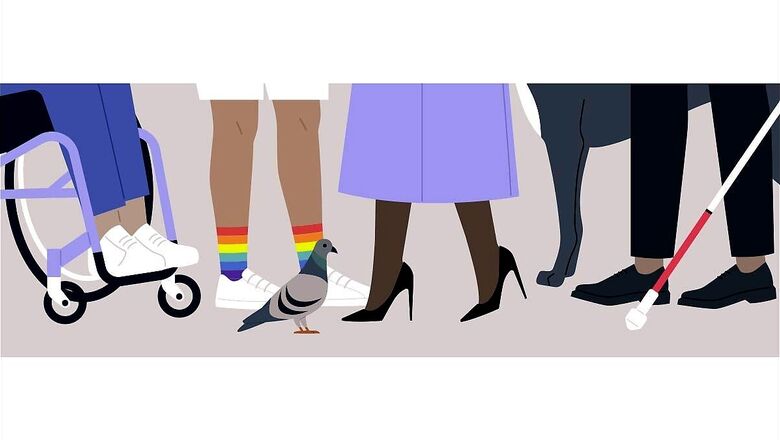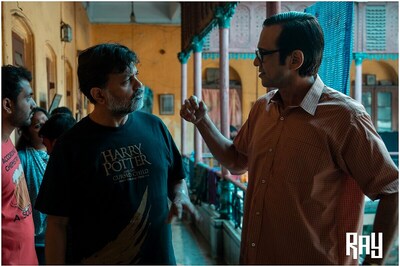
views
Public spaces serve as common ground for individuals from different walks of life. In this context, privacy is the ability of individuals to maintain their personal space and information. Inclusivity, on the other hand, means ensuring that public spaces are welcoming and accessible to all, regardless of gender, age, disability, or identity. In most parts of public life, privacy and inclusivity can coexist comfortably.
The one area that poses a problem, particularly for the LGBTQ+ community, are public toilets. Traditionally, public toilets were divided based on the binary concept of gender. This binary division poses numerous issues as it fails to consider the diversity amongst us. The traditional designs reinforce gender stereotypes and have yet to step into a world where people all along the gender spectrum are both welcome, and respected.
Indian society has already witnessed legal reforms and changes that emphasise gender inclusivity. Public toilets, as essential amenities, play a crucial role in reflecting these updated values – we all use them, after all. So shouldn’t they be designed to reflect all of our identities?
Understanding the LGBTQ+ Community’s Concerns
Understanding the concerns of the LGBTQ+ community is essential in addressing the challenges they face when using public toilets. For transgender and non-binary individuals, using gender-specific toilets amounts to going to the ‘wrong’ toilets. Imagine, for a moment, that you are a man, and are at an event that only has ladies toilets. Would you feel comfortable going to the wrong toilet? Of course, you won’t.
You’d be worried about who would see you go in. You’d be worried that the women inside may confront you. If someone does confront you, you’d feel extremely embarrassed. You’d also be worried about the women calling security, because you’re in the wrong toilet, after all. Now let’s take a step back – why were you in the wrong toilet? Not because you wanted to see what a ladies toilet looks like. You went to the wrong toilet because there were no toilets for men.
This, in a nutshell, is how most transgender and non-binary people feel on a daily basis. Going to the toilet shouldn’t be this stressful, for anyone. This is a problem that doesn’t have a one-size-fits-all solution, unfortunately. In creating bathrooms that are welcoming to the transgender and non-binary community, we need to ensure that these spaces also continue to reflect women’s needs for safety. For example, the user experience of a gender neutral toilet in a well-lit 1000 seater office building that works 24×7 is very different from a gender neutral toilet in a poorly lit alley, late at night.
People, their beliefs, cultural norms, locational nuances – they all play a part in the way we design toilets that balance inclusion with safety and privacy for all.
Best Practices in Inclusive Toilet Design
Signage: Beyond Binary Labels
One of the most visible and contentious aspects of toilet design is signage. Traditionally, public toilets have been segregated by binary gender labels: men and women. These labels are, of course, exclusionary to anyone who doesn’t identify as male or female. Moreover, these labels, especially when depicted pictographically, reinforce stereotypes and norms about what men and women should look like, dress like, and act like.
To address these issues, some toilet designers have adopted more inclusive signage options, such as:
- Using symbols or words that indicate the facilities or functions available in each toilet (e.g., urinals, stalls, sinks, changing tables), rather than gender labels.
- Using neutral or generic terms (e.g., restroom, toilet, WC) or colors (e.g., green, blue) to label toilets, without specifying gender.
- Using symbols or words that explicitly welcome all genders or gender identities (e.g., all-gender, gender-neutral, unisex).
- Providing multiple options for toilet users to choose from (e.g., men’s, women’s, all-gender).
The beauty of signage is that changing it is inexpensive – particularly when compared to the cost of building toilets. It is a quick fix, and it brings in enormous returns. For one, it takes away the problem of using the ‘wrong’ toilet, now that there are toilets that are labeled as gender neutral or all gender toilets. Beyond the LGBTQ+ community, this relabeling also greatly helps parents with children of a different gender, people with disabilities who need assistance from a caregiver of a different gender, or people who simply prefer more privacy or convenience.
Layout: From Segregation to Integration
Toilet designers have adopted more integrated layout options that aim to provide more privacy, safety and inclusivity for all users. Here are some examples of integrated layout options that have worked well, for more inclusive public toilets:
Single-occupancy toilets
These are toilets that can be used by anyone regardless of their gender identity or expression. They are usually lockable and self-contained, meaning they have their own sink, mirror and waste bin. Single-occupancy toilets offer more privacy and security for users who may face discrimination or violence in gender-segregated toilets. They also benefit people with disabilities who need assistance from a caregiver of a different gender, as well as parents or guardians with children of a different gender.
Gender-neutral toilets
These are toilets that are open to anyone regardless of their gender identity or expression. They are usually arranged in a row or a cluster, with each toilet having its own door and partition. Gender-neutral toilets offer more choice and flexibility for users who do not identify with the binary genders of male and female, or who prefer not to disclose their gender when using a toilet. They also reduce the waiting time and congestion that may occur in gender-segregated toilets, especially for women and girls who often face longer queues than men and boys.
Mixed-gender toilets
These are toilets that combine elements of both gender-segregated and gender-neutral toilets. They usually have a common entrance and a shared sink area, but separate sections for male and female users, as well as some gender-neutral cubicles. Mixed-gender toilets offer more options and diversity for users who may have different preferences or needs when using a toilet.
The Role of Education and Awareness
Shedding light on the struggles endured by LGBTQ+ individuals and fostering compassion within society and among policymakers is a fundamental aspect of promoting inclusivity. A joint endeavour of Harpic and News18, Mission Swachhta aur Paani, goes beyond the conventional notions of cleanliness to champion the deep significance of toilets, perceiving them not only as functional spaces but also as havens of security and acceptance for all. This extraordinary mission is rooted in the unwavering belief that clean and inclusive toilets are indispensable for cultivating a society that wholeheartedly embraces and empowers every individual, without any conditions or reservations.
Education and awareness campaigns have immense power to bring about social change. By dispelling myths and stereotypes, these campaigns can cultivate empathy and respect, fostering an environment where the dignity and rights of transgender, non-binary, genderqueer, intersex, and other gender nonconforming individuals are upheld. These campaigns can also add immensely to the legal rights and protections for gender-diverse communities by acting as watchdogs – when allies get involved in monitoring the implementation and enforcement of existing laws and policies, they can hold authorities accountable and demand transparency.
Of course, a well crafted campaign goes a long way in building political will and fostering social support. By engaging with government authorities, policy makers, civil society organisations, social and traditional media, educators, and the general public, they can encourage dialogue, collaboration, and create positive momentum needed to make these changes a reality.
With unwavering commitment, Harpic and News18, through Mission Swachhta aur Paani, actively engage and champion the cause of the LGBTQ+ community, sending a resounding message that every person deserves access to safe and embracing environments where their dignity is upheld and their presence is unquestioned. By aligning their campaigns with Mission Swachhta aur Paani, advocacy groups can boost their efforts to raise awareness and rally public support for inclusive sanitation policies. Together, our collective voices are harder to ignore.
Conclusion
The art of balancing privacy and inclusivity in toilet design extends beyond the provision of a mere public amenity; it involves creating spaces that authentically reflect the values and principles of our society. It is crucial for all stakeholders, including government agencies, designers, and the general public, to collaborate and unite their efforts in constructing environments that cater to the diverse needs of every individual.
By embracing thoughtful toilet designs that harmonise both privacy and inclusivity, we can take significant strides towards fostering an environment where everyone feels genuinely welcomed, respected, and valued. Together, we can shape a future where our public spaces embody our commitment to creating a more just and equitable society; one that celebrates dignity and well-being for all.
Join us here, to learn how you can play a part in this national conversation.



















Comments
0 comment